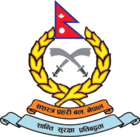This article needs additional citations for verification. (December 2008) |
| Armed Police Force, Nepal | |
|---|---|
 Emblem of the Armed Police Force | |
| Abbreviation | APF, Nepal |
| Motto | PEACE SECURITY COMMITMENT |
| Agency overview | |
| Formed | 2001 |
| Jurisdictional structure | |
| Federal agency | Nepal |
| Operations jurisdiction | Nepal |
| Governing body | Ministry of Home Affairs |
| Constituting instrument |
|
| General nature | |
| Specialist jurisdictions |
|
| Operational structure | |
| Headquarters | Kathmandu, Nepal |
| Agency executive |
|
| Child agency | |
| Website | |
| www | |


The Nepalese Armed Police Force is a land force tasked with counter-insurgency operations in Nepal. It functions as a semi-military wing, and occupies a sort of dual role as both military and law enforcement. Service is voluntary and the minimum age for enlistment is 18 years. Initially founded with a roster of 15,000 police and military personnel, the Armed Police Force was projected to have a corps of 77,117 at the close of 2015.
In February 1996, the ideologically Maoist Communist Party of Nepal operating as the United People's Front of Nepal initiated what was then dubbed the "People's War". Ensuing armed resistance and criminal activity escalating from the conflict motivated King Gyanendra to consider amassing an independent police force. Subsequently, the Armed Police Force was founded on 24 October 2001. Krishna Mohan Shrestha of the Nepal Police (then serving as Additional Inspector General of Police) was its first chief.
The current command and control organization of Nepal's army is outlined along the protocol of the 1990 Constitution and its interim constitution. Its standing Inspector General is the Chief of Armed Police Forces, equivalent in rank to a three-star Lieutenant General of the Nepal Army.
The fundamental ethos of the Armed Police Force (APF) is Peace, Security, Commitment.[citation needed]